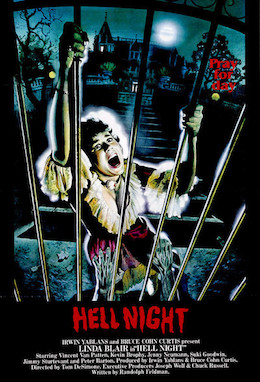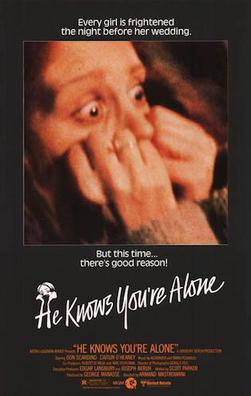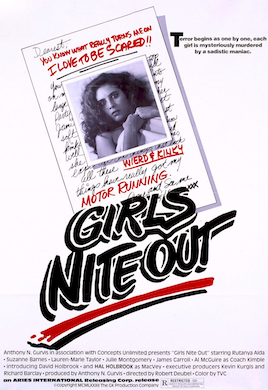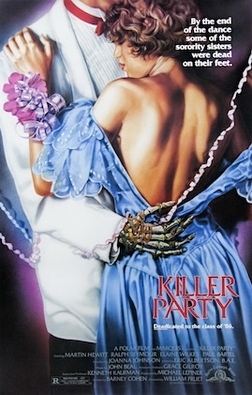
Friday the 13th is a 1980 American independent slasher film produced and directed by Sean S. Cunningham, written by Victor Miller, and starring Betsy Palmer, Adrienne King, Harry Crosby, Laurie Bartram, Mark Nelson, Jeannine Taylor, Robbi Morgan, and Kevin Bacon. Its plot follows a group of teenage camp counselors who are murdered one by one by an unknown killer while they are attempting to re-open an abandoned summer camp with a tragic past.

I Know What You Did Last Summer is a 1997 American slasher film directed by Jim Gillespie, written by Kevin Williamson, and starring Jennifer Love Hewitt, Sarah Michelle Gellar, Ryan Phillippe and Freddie Prinze Jr. It is loosely based on the 1973 novel of the same name by Lois Duncan and is the first installment in the I Know What You Did Last Summer franchise. The film centers on four young friends who are stalked by a hook-wielding killer one year after covering up a car accident in which they supposedly killed a man. The film also draws inspiration from the urban legend known as "The Hook" and the 1980s slasher films Prom Night (1980) and The House on Sorority Row (1982).

Silent Night, Deadly Night is a 1984 American slasher film directed by Charles E. Sellier, Jr., and starring Robert Brian Wilson, Lilyan Chauvin, Gilmer McCormick, Toni Nero, Linnea Quigley, Britt Leach, and Leo Geter. The story concerns a young man named Billy, who suffers from post-traumatic stress over witnessing his parents' murder on Christmas Eve by a man disguised as Santa Claus and his subsequent upbringing in an abusive Catholic orphanage. In adulthood, the Christmas holiday leads him into a psychological breakdown, and he emerges as a spree killer donning a Santa suit.

Prom Night is a 1980 slasher film directed by Paul Lynch and written by William Gray. Jamie Lee Curtis and Leslie Nielsen star. The film's plot follows a group of high school seniors who are targeted at their prom by a masked killer, seeking vengeance for the accidental death of a young girl. The film features supporting performances from Casey Stevens, Eddie Benton, Mary Beth Rubens and Michael Tough.

Terror Train is a 1980 slasher film directed by Roger Spottiswoode in his directorial debut and starring Jamie Lee Curtis, Ben Johnson, and Hart Bochner. The film follows a group of pre-medical school students holding a New Year's Eve costume party on a moving train who are targeted by a killer who dons their costumes. It features supporting performances from Sandee Currie, Anthony Sherwood, and David Copperfield.

My Bloody Valentine is a 1981 Canadian slasher film directed by George Mihalka and written by John Beaird. It stars Paul Kelman, Lori Hallier, and Neil Affleck. The plot tells about a group of young adults who decide to throw a Valentine's Day party, only to incur the vengeful wrath of a maniac in mining gear who begins a killing spree.

Hell Night is a 1981 American supernatural slasher film directed by Tom DeSimone, and starring Linda Blair, Vincent Van Patten, Kevin Brophy, and Peter Barton. The film depicts a night of fraternity hazing set in an old manor—the site of a familial mass murder—during which a deformed killer terrorizes and murders many of the college students. The plot blends elements of slasher films and Gothic haunted house films. Filmmaker Chuck Russell served as an executive producer, while his long-time collaborator Frank Darabont served as a production assistant.

Sleepaway Camp II: Unhappy Campers is a 1988 American slasher film written by Fritz Gordon and directed by Michael A. Simpson. It is the second installment in the Sleepaway Camp film series, and stars Pamela Springsteen as Angela, and Renée Estevez. The film takes place five years after the events of the original, and features serial killer Angela, working as a counselor, murdering misbehaving teenagers at another summer camp.

He Knows You're Alone is a 1980 American psychological slasher film directed by Armand Mastroianni, written by Scott Parker and starring Caitlin O'Heaney, Don Scardino, Elizabeth Kemp, Tom Rolfing, and Tom Hanks in his film debut. The plot follows a woman who is stalked by a killer targeting soon-to-be brides the weekend before her wedding.

The Prowler is a 1981 American slasher film directed by Joseph Zito, written by Neal Barbera and Glenn Leopold, and starring Vicky Dawson, Christopher Goutman, Lawrence Tierney, Cindy Weintraub, and Farley Granger. The film follows a group of college students in a coastal California town who are stalked and murdered during a graduation party by an apparent World War II veteran who killed his ex-girlfriend in 1945.

Girls Nite Out is a 1982 American slasher film written and produced by Anthony N. Gurvis, directed by Robert Deubel, and starring Julia Montgomery, Suzanne Barnes, Rutanya Alda, and Hal Holbrook. The film focuses on a group of female college students who are targeted by a killer in a bear mascot costume during an all-night scavenger hunt on their campus.

Death Screams is a 1982 American slasher film directed by David Nelson.

Home Sweet Home is a 1981 American slasher film directed by Nettie Peña, and written by Thomas Bush. It stars Jake Steinfeld, Peter De Paula, and Vinessa Shaw in her film debut, and the plot focuses on a PCP-addicted killer who terrorizes a family in their remote home on Thanksgiving. Along with Blood Rage and the faux Thanksgiving trailer from Grindhouse which would later be fully adapted as Thanksgiving, it is one of the few slasher films centered on the Thanksgiving holiday, and one of the few to be directed by a woman.

To All a Goodnight is a 1980 American slasher film directed by David Hess and starring Jennifer Runyon and Forrest Swanson. Its plot follows a group of female finishing school students and their boyfriends being murdered during a Christmas party by a psychopath dressed as Santa Claus.

Bloody Moon is a 1981 English-language Spanish-German slasher film directed by Jesús Franco and starring Olivia Pascal.

Slumber Party Massacre III is a 1990 American slasher film directed by Sally Mattison and written by Catherine Cyran. It is the third and final installment in the original Slumber Party Massacre trilogy, and stars Keely Christian, Brittain Frye, M.K. Harris, David Greenlee, Hope Marie Carlton and Maria Ford. The film follows a group of teenage girls in California, whose slumber party is crashed by a masked killer.

Killer Party is a 1986 Canadian supernatural slasher film directed by William Fruet, and starring Martin Hewitt, Ralph Seymour, Elaine Wilkes, Joanna Johnson, Sherry Willis-Burch, and Paul Bartel. It follows a trio of female sorority pledges who unleash a demonic force after participating in an initiation ritual in an abandoned house on their university's campus.
Tom DeSimone is an American director, writer, producer and editor, perhaps best known for directing the cult films Chatterbox (1977), Hell Night (1981), and The Concrete Jungle (1982) and a number of pornographic films for Hand in Hand Films, a gay production studio established in the "golden age" of adult films in the early 1970s.

The Deadly Camp is a 1999 slasher film written and directed by Bowie Lau, and co-written by Kenneth Hau Wai Lai.

Silent Night, Deadly Night is an American Christmas horror film series, consisting of six films. The first film in the series, Silent Night, Deadly Night (1984), originally titled Slay Ride, tells the story of Billy, a young man who experiences a psychotic break and goes on a murder spree dressed as Santa Claus. The film received theatrical distribution from TriStar Pictures, but was pulled from theaters in November 1984 after a series of protests against the film.



















